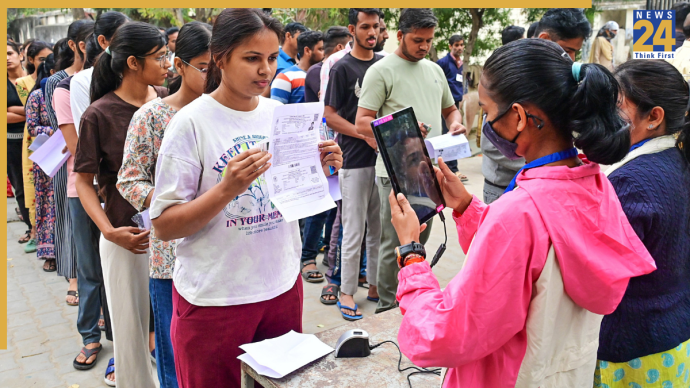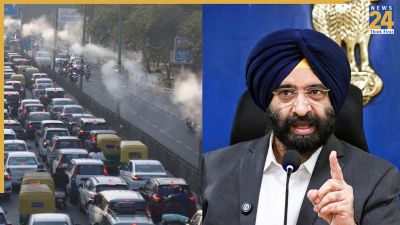New Delhi: The day has finally arrived when we will be witnessing the blasts which will result in the demolition of the Supertech Twin Towers located in Sector-93 A in Noida, Uttar Pradesh. The two towers namely Apex (32 storeys) and Ceyane (29 storeys) will fall like a house of cards in 9 seconds.
No matter how fascinating it may sound but the after-math of the blast will leave behind approximately 35,000 cubic metres of debris. It will take at least 3 months to be cleared-off. There is a high possibility of affects that might be induced on the people living in the area.
To understand these impacts and possible solutions to avoid or minimize them Mayank Kasyap of News 24 talked to Dr Sharad Joshi. He is the Associate Director of Pulmonology at Max Super Specialty Hospital, Vaishali.
He tried to figure out possible effects on the physical health, and abstract conditions of the people living within the impact radius of the blast site.
Mayank: What will be the impact intensity of this blast on the people living in the vicinity of the Twin Towers?
Dr Sharad: That depends on the amount of particles suspended in the atmosphere. As you are aware of the (severe) level of pollution faced by Delhi-NCR every year. The AQI levels are alarming specially during the months of October, November and December.
If you go by the WHO’s (World Health Organization) criteria, 50 is the AQI level which is recommended. Condition of the air quality was fairly good during the Covid-19 era due to lockdowns. But otherwise even during winters the AQI goes up to 1100 which is highly toxic. This is just like living in a gas chamber.
To talk about this demolition of the building, there will be a lot of dust particles which will be suspended into the air. The particle size will definitely vary from PM 10, PM 5 and even PM 2.5. This will be almost similar effect as we have seen in winters during dense fog. They have very bad AQI.
After that the patients who will be in the immediate vicinity of that blast will get a very high exposure to dust may experience RDS (Respiratory Distress Syndrome) which is acute exposure to that dust and smoke.
Mayank: Is there a specific age-group which is more vulnerable to the residue of the demolition?
Dr Sharad: Not everybody is vulnerable to it. The thing is, clearing of those particles from lungs and body will depend on the human function which might be low functioning in pediatric groups, the kids and the elderly group who are already suffering from some lung disease. The younger population and healthy population will definitely clear it off from their lungs and body faster. But the vulnerable population will suffer from it for longer.
People might also suffer from Reactive Airways Dysfunction Syndrome (RADS) which is caused from acute exposure to dust and smoke. Patients who are already asthmatic and are on inhalers, their requirements for drugs, nebulization, and oxygen might increase. So this might result in worsening of asthma.
Mayank: Can you also tell me about the short-term and long-term impacts that people might experience?
Dr Sharad: That will definitely depend on the exposure. How much you are exposed to net dust. In short term, there will be like burning of eyes, conjunctivitis, defects on the upper airway like sneezing and respiratory distress because of nasal blockage or runny nose, blocked nose, sneezing, headaches. It will be confined to upper airways. But that will definitely have lower airway effects as well like RDS or asthma, worsening of COPD, these are long term effects and they will remain for longer duration.
Mayank: What about the residue from the blast particle that will be used for the explosion? They will be using approximately 3700 kg of blast material for the demolition of the Twin Towers?
Dr Sharad: The people who are regularly involved in blasting, they can develop the non-reversible lung disease which is called silicosis.
Mayank: Because they inhale silica particles.
Dr Sharad: Yes, so that silica remains inside their lungs and is inert. In the long run, silicosis will cause restrictions and the size of the lungs will reduce. So their intake capacity of oxygen is affected.
Mayank: So, do they become more vulnerable to other respiratory diseases as well also?
Dr Sharad: Yes they can. But silicosis is a chronic lung disease. Similarly, COPD is one such disease which will remain throughout the life. It doesn’t gets cured. Silicosis too will not get cured, the patient has to live with it.
Mayank: Can the noise affect old people or infants? Can the shockwaves disintegrate some aspects of human physiology?
Dr Sharad: Blast injury per se can cause life threatening complications. If there is a huge blast within a close proximity, your lungs might rupture, a patient’s lung can rupture, your eardrum can rupture. Any organ which contains air in the body can actually rupture because of the shockwaves from blast. And that is the reason that huge evacuation has been done in almost one kilometer radius.
Mayank: Is there anything else that you might want to add regarding the impact blast injuries?
Dr Sharad: The impact of blast injury will not be short term or long term. It will be immediate emergency. The blast can actually rupture the lungs, intestines or eardrum. This will result in heavy bleeding from the ear. The blast will increase the intensity of reverberations of air which can lead to the rupturing of any organ which contains air.
It is very important that everybody should stay away from the blast effect. After the blast and demolition, definitely, a lot of water sprinkling should be done so that the dust settles down. And it does not remain suspended in the air.
So, there is a reason that evacuation in a radius of almost one kilometer has been done. It is very important. See the blast waves they traveled very fast, similar to the velocity of sound. Lastly, it can actually cause life threatening complications. It is best that general public remains out of that particular radius
Mayank: How long do you think the residue generated from the blast will remain suspended in the atmosphere?
Dr Sharad See, that depends upon the measures taken after the demolition. If we are actively sprinkling water, the particles will settle down faster. If we are using huge air purifiers in the immediate vicinity of the blast, definitely the particles will settle down faster.
So to monitor all those things, the team which is demolishing this (Twin Towers), have installed the AQI measuring machines in and around the area. They have done this in order to check the quality of air around the blast site.
Mayank: Can the shockwaves created from the blasts result in cardiac arrest?
Dr Sharad: Yes, that can also happen as a result of blast injuries or by the shockwave created by the blasts. But that will only occur if you are in the close proximity of the blast. If someone is sitting 3 kilometers away he is definitely safe. If you are in the impact zone, then definitely the cardiac arrest can happen.
Mayank: What can be the impact radius, given the quantity of the blast material to be used is around 3700 kgs?
Dr Sharad: That’s that’s quite technical question. People of the company which is actually carrying out this demolition, either they or their technical team might be knowing the blast radius or the impact radius.
Mayank: Edifice Engineering with its South African partner Jet Demolitions, are spearheading the entire exercise. They have set-up four layers of iron mesh and two layers of blanket so no rubble can fly past it but dust will. The detonation will be done from a distance of 50 to 70 meters. So, is it possible that these defense mechanism might not fair well in subsiding the impact of the blast?
Dr Sharad: Yes, certainly! It will break down the propagation of the shockwave. That will also break down the propagation of the dust particles. So it’s a good move. Fortunately, the company which is carrying out this demolition, they have quite a long professional expertise. That is one thing which is very very good and favorable for the area.
Mayank: Do you want to add anything else, any other advice for general population of the area?
Dr Sharad: My advice for general population is although this might be a lifetime sight to visualize such a thing that two buildings, two towers are being demolished in NCR. For their own safety they should stay away from there. fears, Wear N-95 mask or double mask. And if you live in the vicinity, it is preferable to move away at least 1.5 kilometers on the day of the blast. Later on, for the authorities, it will be important that they continue to sprinkle water. So that dust particle settle down faster. And we evaluate the situation according to the machines which are measuring the AQI in the surrounding area.
Mayank: Are there some measures that has to be taken for the general public from the government’s end? Things that you think is necessary after a blast on such massive scale?
Dr Sharad: Yes, definitely! So at individual level, stay away during the blast. And if possible use air-purifier at home. Wear your mask so that the dust particles are not entering your airways.
And at the government’s level, definitely. Such a thing is actually a disaster. We allow something (to be built) which needs to be demolished (later)? In the first place, they should have not let it happen. They should not need such demolitions.
It’s actually a double loss of economy. First you spent money on its construction, now you are spending money on its demolition. It is a double loss for the society. Moreover, you are creating a health hazard for everyone around. I think, regulations and sanctions for (such) buildings should be very strict.













